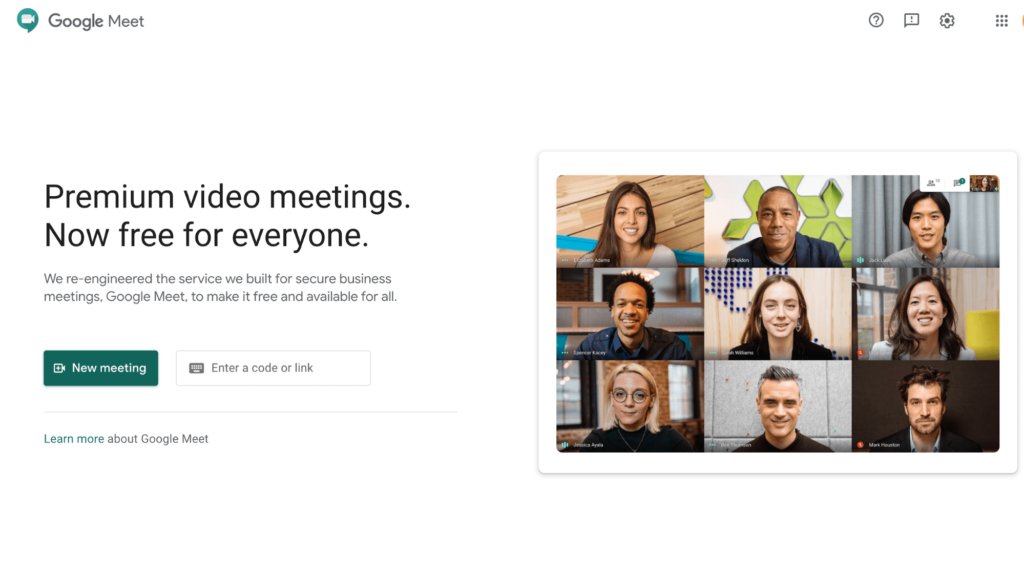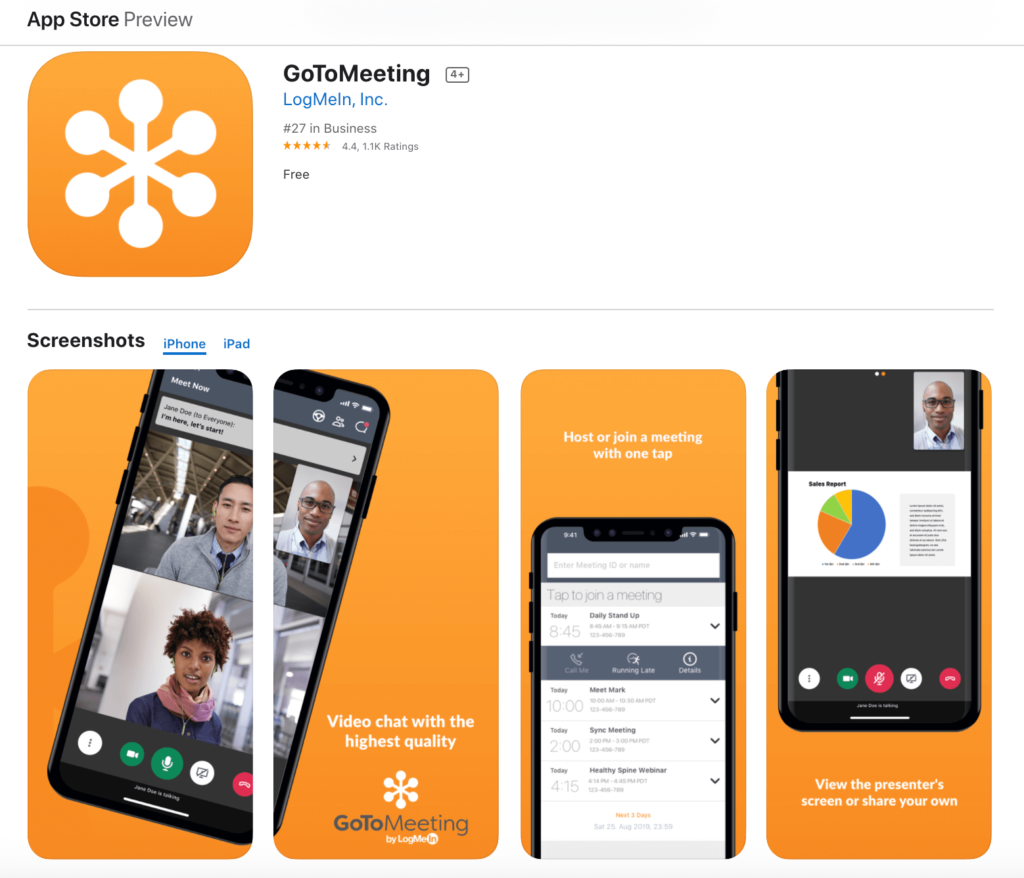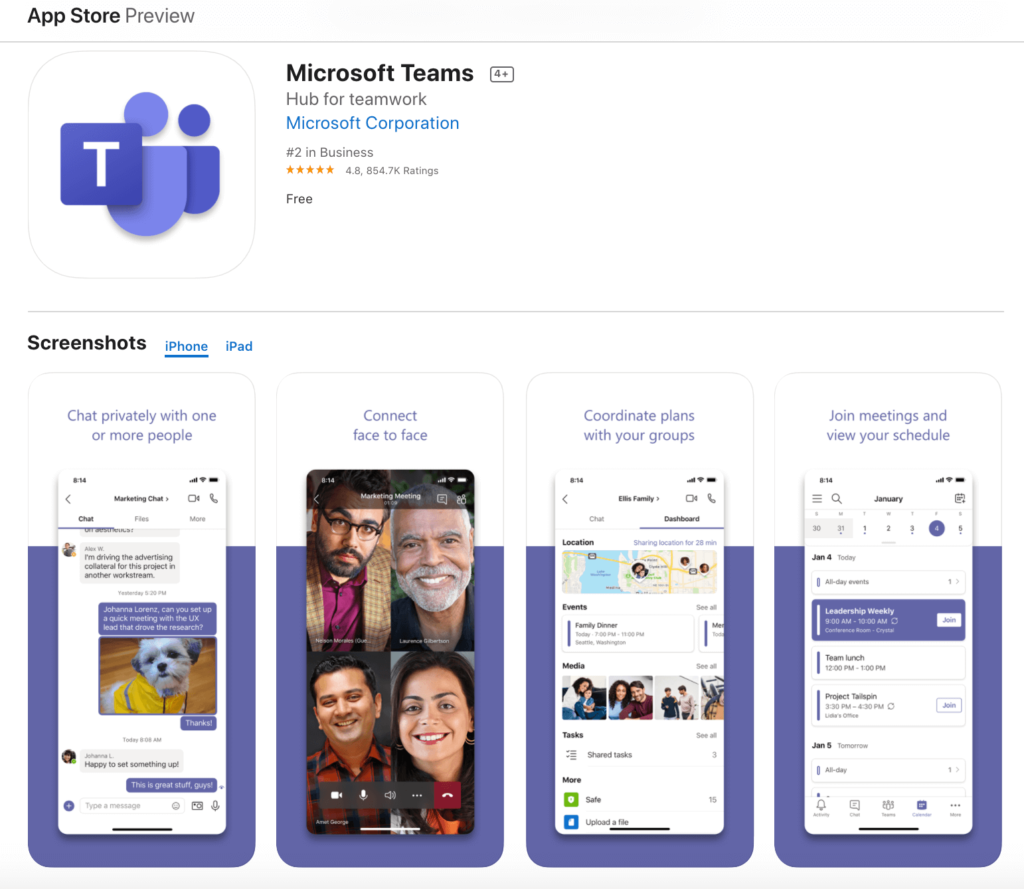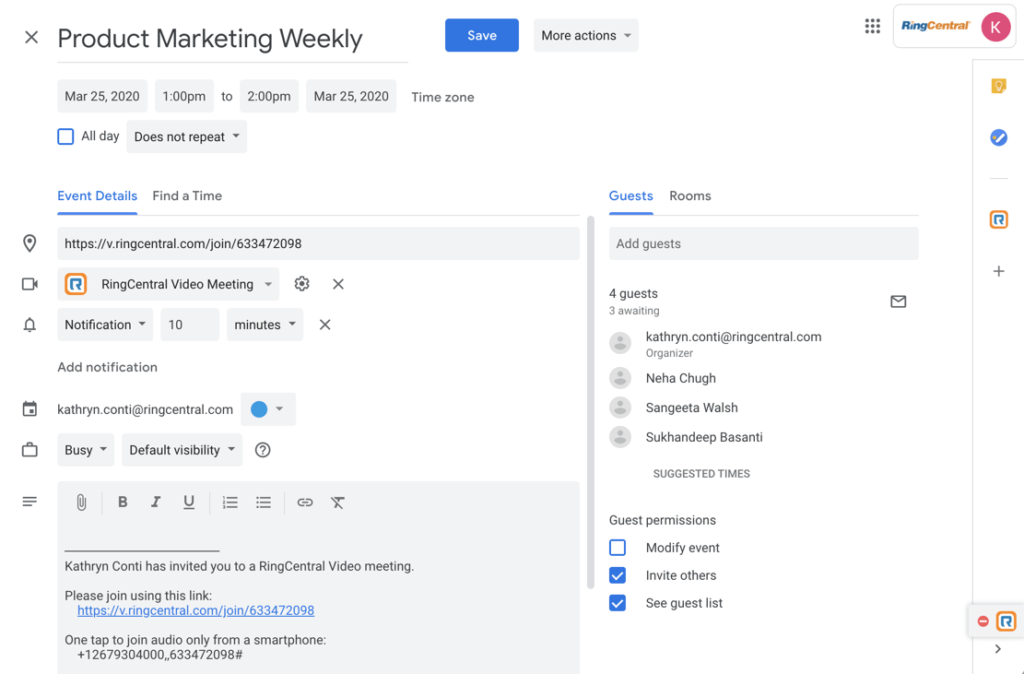You might be using a video chat app like Facebook Messenger, WhatsApp, or Snapchat to communicate with your friends or families on a day-to-day basis.
But when it comes to communicating at work, your requirements are probably going to be very different than that of a family WhatsApp group video chat.
For example, you need a video conferencing tool that allows you to accommodate (at least) two or three people in a meeting at once. You probably also need video conferencing software that allows you to record your meetings, share your screen with others, or automatically back up your recording once the session is over.
And although WhatsApp and Messenger are great consumer video calling apps, you can’t expect them to offer the above-mentioned advanced features.
Since we’ve built a video conferencing platform ourselves, we know a thing or two about what makes a video software click for businesses.
For starters, we know that not all video conferencing software are created equal—especially when it comes to video tools for Mac computers.
If your company uses Macs for work, your choices have to be even more specific to match the productivity and performance levels of Mac computers.
In this post, we’re going to show you:
- 3 things to look for in a video conferencing software for a Mac
- 5 best video conferencing software for Mac
🛒 Shopping for a video conferencing tool? (Or just curious about what to look for?) Grab the free checklist to help you choose the right one for your team or business.
What specifically to look for in a video conferencing software for a Mac
Mac computers are very different from PCs and mobile devices in terms of performance and security. If your company exclusively uses Macs for work, it’s likely because you value speed, design, and productivity as must-have features.
The same rule applies when you’re looking to invest in a video conferencing software for your Mac. You want a video chat tool that works on par with Mac’s performance level.
Mac is primarily known for three things: solid hardware design, faster data processing, and better security against viruses and malware.
Hardware isn’t an issue when narrowing down your choice of video conferencing software. But you should certainly prioritize speed and security when choosing a Mac video conferencing app.
Apart from that, here are a few more things that you should keep in mind if you’re thinking, “How do I video conference on my iMac?”
1. A Mac-compatible app
Almost all the major video conferencing software options out there have an app on Apple’s App Store. But it’s not always the case, especially when you come across a new video chat solution that’s free or less costly.
For example, Zoho Meeting has an app for iPhone and iPad, but it doesn’t offer an app for Mac computers.
(So, always check the App Store!)
In these cases, one of your options is to find a video conferencing app that doesn’t require an app download. But even if you can just have a virtual meeting in your internet browser, that doesn’t mean it’s the best way to go—you’re missing out on a lot of functionality when you don’t have a good app.
A better option is to choose with an app that has a dedicated app on Mac, such as the RingCentral app with video conferencing. Apple has a very high bar for featuring apps in its App Store, which means most video conferencing apps in Mac are—by design—user-friendly, reliable, and secure.
2. Does it do more with less?
As a small business owner, you want to choose a video conferencing tool that offers useful capabilities—without compromising on performance.
So, try to find a video conferencing tool that does other things well too—there are apps, for example, that let you make video calls and phone calls and send your team messages, in one place:
The more things your video conferencing platform can do, the fewer apps you’ll need to download onto your Mac. Which, ultimately, frees up more space, keeps it running faster, and so on…
3. Does it have HD capability?
This is a no-brainer, especially if you’re working at a remote-friendly company that uses videos to collaborate regularly within your team or clients.
The last thing you would want in the middle of an engaging video chat session is for your participants to see pixelated pop art versions of each other and choppy audio bites echoing in the background.
So, make sure your video conferencing tool offers high-definition (HD) videos and audio capability. Depending on how many people you regularly meet with, you might want to set your expectations to hosting at least 20 (or 50, or even 100) participants at a time without compromising on your audio and video quality.
If you’re a growing company, it’s much better to identify a video chat tool that offers these features right out of the gate. This will prepare you and give you room to grow as you scale, as opposed to leaving you to scramble for a better tool later on.
5 best video conferencing software for Mac
The tools that we’ve shortlisted below do more than just one thing. (If you want just a standalone basic video conferencing software, then Apple’s own FaceTime pretty much covers it all.)
But as a startup owner, you know better. You want tools that let you record your videos, annotate files together while on meetings, store backups, and do a lot more than just have a video call.
We’re also going to leave out tools that operate on dubious grounds of data breach and user privacy. Better to just steer clear of those.
Let’s get down to the list.
1. RingCentral Video
RingCentral’s app is a truly cross-functional platform that packs the power of video conferencing, team collaboration, and a business phone—all into one.
Whether you’re using a Mac or an iPhone (or both), you can use RingCentral Video to host video meetings in a few different ways.
You can start a meeting in the desktop or mobile app designed for iOS:
And if your attendees aren’t on Macs or don’t have the Android app, they can still join your meeting from a web browser without downloading anything:
The base plan still lets you have a maximum of 100 participants (designed for if your customers or clients have many stakeholders involved in projects, or if you’re planning to grow your team).
Record your meetings and save them in the cloud or on your computer—and oh, there’s the chat box that lets you add another conversational aspect to a video meeting…
Plus the real-time annotations that you and your teammates can add while collaborating:

From call scheduling to video recording to screen sharing to messaging, RingCentral Video gives you literally everything you need—and more—to make the most out of your video meetings.
Using RingCentral for your video conferencing needs makes a lot of sense if your startup teams are already using Slack, Google Workspace, or Microsoft 365 to collaborate and communicate effectively.
Best for: Close-knit teams who want to be able to collaborate tightly with each other in different ways including over the phone, video calls, and chat. RingCentral is also a great fit for your team if you use videos to host webinars or offer customer support. (There’s a contact center solution too!)
Price: RingCentral Video comes with the RingCentral Office plan, which starts at $24.99/user/month which gives you an unlimited number of users, unlimited audio conferencing, video meetings with up to 100 people, 24/7 support, and more.
🕹️ Get a hands-on look at how RingCentral works for Macs by booking a product tour:
💰 You can also use this calculator to see roughly how much your business could save by using RingCentral to support your team’s communication with each other—and clients.
2. Zoho Cliq
When it comes down to video conferencing, Zoho offers two options—Zoho Meeting and Zoho Cliq. In this post, we will take a closer look at Zoho Cliq as a video conferencing option.
The good thing about getting a Zoho product for your business is that you can tap into the vast range of other Zoho apps, which means Zoho Cliq integrates with major platforms like Zoho Projects, Zoho CRM, and Zoho Desk.
Zoho Cliq started as a team messaging platform and evolved into a voice and video communication platform later:

Chat continues to be one of its most powerful features which—unlike other messaging apps like Slack—allows you to branch posts from an existing thread and turn it into a 1:1 private message.
This lets you retain the context of the original conversation while saving you time to dig deep into confusing threads of long conversations.
But if chat is too asynchronous (happening in succession instead of real time) for you, use Zoho Cliq’s video chat on Mac to collaborate better with your colleagues.
You can also attach and share important files and other documents to make your online collaboration more effective.
Best for: Companies that are looking for a better, more affordable alternative to Slack. If messaging is a core part of your collaboration along with video chat, Zoho Cliq’s easy chat interface and contextual thread-branching might be good for you.
3. Google Meet
Google took one of its underdog products—Hangouts Meet—and rebranded it as Google Meet, right on time during the pandemic to cater to the surging demands of video conferencing apps.
And it looks like the rebranding has worked well for Google because several startups are adopting Google Meet as a better alternative to more expensive, less secure platforms like Zoom.
Google Meet also comes with the usual set of features like its Zoho counterpart—mobile compatibility, video meetings on the go, and plenty of integrations within and outside the Google Workspace ecosystem.
The only downside—it doesn’t have an app for Mac. Google Meet is only available for download on iPad and iPhones.

In our view, what makes Google Meet stand out from its competition is the option to enable live text captions on videos—currently only available in English.
So in case you experience video latency or audio issues while in a meeting, you can still make sense of the conversation via the captions that appear along with the speaker.
Sadly, Google Meet missed the mark by not offering an option to download or save the captions, which could have made it easy for users to transcribe their video meetings into text notes.
Best for: If you frequently use videos as a channel to face customers or run instructional video sessions. Joining a meeting through the browser or mobile apps make it easy for users to directly dial from their computer or phone.
4. GoToMeeting
On top of being one of the oldest video conferencing tools out there, GoToMeeting for Mac is also a pretty simple platform to use. It has a basic, intuitive user interface that doesn’t confuse you with lots of unnecessary controls.
GoToMeeting automatically adjusts the bandwidth processing for you based on your network speed, which means all meeting participants can enjoy a seamless video experience without the risk of audiovisual breakdown.
GoToMeeting also offers a softphone feature, which is similar to RingCentral’s VoIP (voice-over internet protocol) function. You can use the softphone to make audio-only phone calls over the internet:

GoToMeeting has plugins with Microsoft Outlook, MS Microsoft 365, Google Calendar, and the Chrome browser. This allows you to host or join a video call in one click through these third-party platforms.
Other add-on features include live chat, remote access to users, and meeting rooms for smaller groups to join recurring meetings.
Best for: Businesses of all shapes and sizes that are interested in little extra perks like live chat, remote screen access, or a softphone capability.
5. Microsoft Team
When Microsoft Teams joined the fray of team messaging apps in 2016, many accused it of copying Slack in terms of the UI, features, and other offerings.
Oblivious to the criticism, Microsoft Teams kept positioning itself as a successor of Skype and grew at a steady pace. By the latest 2020 estimates, it grew its daily active users (DAU) to 75 million, and even surpassed Slack in DAUs.
All this to say that Microsoft Teams for Mac is a robust team messaging and video conferencing tool that draws its winning streak from the same fountain of knowledge that has enabled other Microsoft products to succeed:

In addition to the native integration with other Microsoft apps, it offers out-of-the-box integrations with major players like RingCentral, ServiceNow, and Wrike.
This broadens your scope of collaboration across teams if you are already using one of these software in your business.
Best for: Businesses that are already using Microsoft 365 as their preferred choice of software. If you were using Skype for your video conferencing needs, it makes sense to upgrade to Microsoft Teams because of the ease of pricing and feature-rich capabilities the latter offers.
Spur your productivity with the best video conferencing software for Mac
If there’s one thing we want you to take away from this post, it’s this—don’t select a video conferencing app that you might find randomly in the Apple’s App Store.
There are several non-descript video chat apps for Mac that promise several features. But more often than not, they turn out to be indie apps that are yet to mature into full-fledged video platforms.
Go with apps that have a proven track record or the one that aligns with your specific business needs. Make sure the app that you choose does more than just one thing to ensure you get your value for money.
And if you want to save the time and hassle looking for a good video solution—play it safe with the RingCentral app for Mac.
Originally published Aug 14, 2020, updated May 29, 2024








